Abstract
Summary
Computerized analysis of the trabecular structure was used to test whether femur failure load can be estimated from radiographs. The study showed that combined analysis of trabecular bone structure and geometry predicts in vitro failure load with similar accuracy as DXA.
Introduction
Since conventional radiography is widely available with low imaging cost, it is of considerable interest to discover how well bone mechanical competence can be determined using this technology. We tested the hypothesis that the mechanical strength of the femur can be estimated by the combined analysis of the bone trabecular structure and geometry.
Methods
The sample consisted of 62 cadaver femurs (34 females, 28 males). After radiography and DXA, femora were mechanically tested in side impact configuration. Fracture patterns were classified as being cervical or trochanteric. Computerized image analysis was applied to obtain structure-related trabecular parameters (trabecular bone area, Euler number, homogeneity index, and trabecular main orientation), and set of geometrical variables (neck-shaft angle, medial calcar and femoral shaft cortex thicknesses, and femoral neck axis length). Multiple linear regression analysis was performed to identify the variables that best explain variation in BMD and failure load between subjects.
Results
In cervical fracture cases, trabecular bone area and femoral neck axis length explained 64% of the variability in failure loads, while femoral neck BMD also explained 64%. In trochanteric fracture cases, Euler number and femoral cortex thickness explained 66% of the variability in failure load, while trochanteric BMD explained 72%.
Conclusions
Structural parameters of trabecular bone and bone geometry predict in vitro failure loads of the proximal femur with similar accuracy as DXA, when using appropriate image analysis technology.





Similar content being viewed by others
References
Anonymous (1993) Consensus development conference: diagnosis, prophylaxis, and treatment of osteoporosis. Am J Med 94:646–650
Legrand E, Chappard D, Pascaretti C, Duquenne M, Krebs S, Rohmer V, Basle MF, Audran M (2000) Trabecular bone microarchitecture, bone mineral density, and vertebral fractures in male osteoporosis. J Bone Miner Res 15:13–19
Hudelmaier M, Kollstedt A, Lochmüller EM, Kuhn V, Eckstein F, Link TM (2005) Gender differences in trabecular bone architecture of the distal radius assessed with magnetic resonance imaging and implications for mechanical competence. Osteoporos Int 16:1124–1133
Chappard C, Brunet-Imbault B, Lemineur G, Giraudeau B, Basillais A, Harba R, Benhamou CL (2005) Anisotropy changes in post-menopausal osteoporosis: characterization by a new index applied to trabecular bone radiographic images. Osteoporos Int 16:1193–1202
Benhamou CL, Poupon S, Lespessailles E, Loiseau S, Jennane R, Siroux V, Ohley W, Pothuaud L (2001) Fractal analysis of radiographic trabecular bone texture and bone mineral density: two complementary parameters related to osteoporotic fractures. J Bone Miner Res 16:697–704
El-Kaissi S, Pasco JA, Henry MJ, Panahi S, Nicholson JG, Nicholson GC, Kotowicz MA (2005) Femoral neck geometry and hip fracture risk: the Geelong osteoporosis study. Osteoporos Int 16:1299–1303
Partanen J, Jämsä T, Jalovaara P (2001) Influence of the upper femur and pelvic geometry on the risk and type of hip fractures. J Bone Miner Res 16:1540–1546
Pulkkinen P, Partanen J, Jalovaara P, Jämsä T (2004) Combination of bone mineral density and upper femur geometry improves the prediction of hip fracture. Osteoporos Int 15:274–280
Alonso CG, Curiel MD, Carranza FH, Cano RP, Perez AD (2000) Femoral bone mineral density, neck-shaft angle and mean femoral neck width as predictors of hip fracture in men and women. Multicenter Project for Research in Osteoporosis. Osteoporos Int 11:714–720
Gnudi S, Ripamonti C, Lisi L, Fini M, Giardino R, Giavaresi G (2002) Proximal femur geometry to detect and distinguish femoral neck fractures from trochanteric fractures in postmenopausal women. Osteoporos Int 13:69–73
Järvinen TL, Sievänen H, Jokihaara J, Einhorn TA (2005) Revival of bone strength: the bottom line. J Bone Miner Res 20:717–720
Anonymous (1994) Assessment of fracture risk and its application to screening for postmenopausal osteoporosis. Report of a WHO Study Group. World Health Organ Tech Rep Ser 843:1–129
Schuit SC, van der Klift M, Weel AE, de Laet CE, Burger H, Seeman E, Hofman A, Uitterlinden AG, van Leeuwen JP, Pols HA (2004) Fracture incidence and association with bone mineral density in elderly men and women: the Rotterdam Study. Bone 34:195–202
Robbins JA, Schott AM, Garnero P, Delmas PD, Hans D, Meunier PJ (2005) Risk factors for hip fracture in women with high BMD: EPIDOS study. Osteoporos Int 16:149–154
Kanis JA (2002) Diagnosis of osteoporosis and assessment of fracture risk. Lancet 359:1929–1936
Marshall D, Johnell O, Wedel H (1996) Meta-analysis of how well measures of bone mineral density predict occurrence of osteoporotic fractures. BMJ 312:1254–1259
Nicholson PH, Müller R, Cheng XG, Ruegsegger P, Van Der Perre G, Dequeker J, Boonen S (2001) Quantitative ultrasound and trabecular architecture in the human calcaneus. J Bone Miner Res 16:1886–1892
Njeh CF, Fuerst T, Diessel E, Genant HK (2001) Is quantitative ultrasound dependent on bone structure? A reflection. Osteoporos Int 12:1–15
Bauer JS, Kohlmann S, Eckstein F, Mueller D, Lochmüller EM, Link TM (2006) Structural analysis of trabecular bone of the proximal femur using multislice computed tomography: a comparison with dual X-ray absorptiometry for predicting biomechanical strength in vitro. Calcif Tissue Int 78:78–89
Showalter C, Clymer BD, Richmond B, Powell K (2006) Three-dimensional texture analysis of cancellous bone cores evaluated at clinical CT resolutions. Osteoporos Int 17:259–266
Müller R, Van Campenhout H, Van Damme B, Van Der Perre G, Dequeker J, Hildebrand T, Ruegsegger P (1998) Morphometric analysis of human bone biopsies: a quantitative structural comparison of histological sections and micro-computed tomography. Bone 23:59–66
Herlidou S, Grebe R, Grados F, Leuyer N, Fardellone P, Meyer ME (2004) Influence of age and osteoporosis on calcaneus trabecular bone structure: a preliminary in vivo MRI study by quantitative texture analysis. Magn Reson Imaging 22:237–243
Link TM, Majumdar S, Lin JC, Newitt D, Augat P, Ouyang X, Mathur A, Genant HK (1998) A comparative study of trabecular bone properties in the spine and femur using high resolution MRI and CT. J Bone Miner Res 13:122–132
Mueller D, Link TM, Monetti R, Bauer J, Boehm H, Seifert-Klauss V, Rummeny EJ, Morfill GE, Raeth C (2006) The 3D-based scaling index algorithm: a new structure measure to analyze trabecular bone architecture in high-resolution MR images in vivo. Osteoporos Int 17:1483–1493
Lammentausta E, Hakulinen MA, Jurvelin JS, Nieminen MT (2006) Prediction of mechanical properties of trabecular bone using quantitative MRI. Phys Med Biol 51:6187–6198
Vokes TJ, Giger ML, Chinander MR, Karrison TG, Favus MJ, Dixon LB (2006) Radiographic texture analysis of densitometer-generated calcaneus images differentiates postmenopausal women with and without fractures. Osteoporos Int 17:1472–1482
Pothuaud L, Lespessailles E, Harba R, Jennane R, Royant V, Eynard E, Benhamou CL (1998) Fractal analysis of trabecular bone texture on radiographs: discriminant value in postmenopausal osteoporosis. Osteoporos Int 8:618–625
Gregory JS, Stewart A, Undrill PE, Reid DM, Aspden RM (2004) Identification of hip fracture patients from radiographs using Fourier analysis of the trabecular structure: a cross-sectional study. BMC Med Imaging 4:4
Lin JC, Grampp S, Link T, Kothari M, Newitt DC, Felsenberg D, Majumdar S (1999) Fractal analysis of proximal femur radiographs: correlation with biomechanical properties and bone mineral density. Osteoporos Int 9:516–524
Chappard D, Chennebault A, Moreau M, Legrand E, Audran M, Basle MF (2001) Texture analysis of X-ray radiographs is a more reliable descriptor of bone loss than mineral content in a rat model of localized disuse induced by the Clostridium botulinum toxin. Bone 28:72–79
Guggenbuhl P, Bodic F, Hamel L, Basle MF, Chappard D (2006) Texture analysis of X-ray radiographs of iliac bone is correlated with bone micro-CT. Osteoporos Int 17:447–454
Veenland JF, Grashuis JL, Weinans H, Ding M, Vrooman HA (2002) Suitability of texture features to assess changes in trabecular bone architecture. Pattern Recogn Lett 23:395–403
Singh M, Nagrath AR, Maini PS (1970) Changes in trabecular pattern of the upper end of the femur as an index of osteoporosis. J Bone Joint Surg Am 52:457–467
Smyth PP, Adams JE, Whitehouse RW, Taylor CJ (1997) Application of computer texture analysis to the Singh Index. Br J Radiol 70:242–247
Pietka E (1994) Lung segmentation in digital radiographs. J Digit Imaging 7:79–84
Petric N, Chan HP, Sahiner B, Helvie MA (1999) Combined adaptive enhancement and region-growing segmentation of breast masses on digital mammograms. Med Phys 26:1642–1654
Paquerault S, Yarusso LM, Papaioannou J, Jiang Y, Nishikawa RM (2004) Radial gradient-based segmentation of mammographic microcalcifications: observer evaluation and effect on CAD performance. Med Phys 31:2648–2657
Chabat F, Desai SR, Hansell DM, Yang GZ (2000) Gradient correction and classification of CT lung images for the automated quantification of mosaic attenuation pattern. J Comput Assist Tomogr 24:437–447
Haris K, Efstratiadis SN, Maglaveras N, Pappas C, Gourassas J, Louridas G (1999) Model-based morphological segmentation and labeling of coronary angiograms. IEEE Trans Med Imaging 18:1003–1015
Santos VT, Schiabel H, Goes CE, Benatti RH (2002) A segmentation technique to detect masses in dense breast digitized mammograms. J Digit Imaging 15(Suppl 1):210–213
Veenland JF, Link TM, Konermann W, Meier N, Grashuis JL, Gelsema ES (1997) Unraveling the role of structure and density in determining vertebral bone strength. Calcif Tissue Int 61:474–479
Veenland JF, Grashuis JL, Gelsema ES (1998) Texture analysis in radiographs: the influence of modulation transfer function and noise on the discriminative ability of texture features. Med Phys 25:922–936
Lochmüller EM, Krefting N, Burklein D, Eckstein F (2001) Effect of fixation, soft-tissues, and scan projection on bone mineral measurements with dual energy X-ray absorptiometry (DXA). Calcif Tissue Int 68:140–145
Eckstein F, Wunderer C, Boehm H, Kuhn V, Priemel M, Link TM, Lochmüller EM (2004) Reproducibility and side differences of mechanical tests for determining the structural strength of the proximal femur. J Bone Miner Res 19:379–385
Eckstein F, Lochmüller EM, Lill CA, Kuhn V, Schneider E, Delling G, Müller R (2002) Bone strength at clinically relevant sites displays substantial heterogeneity and is best predicted from site-specific bone densitometry. J Bone Miner Res 17:162–171
Lochmüller EM, Groll O, Kuhn V, Eckstein F (2002) Mechanical strength of the proximal femur as predicted from geometric and densitometric bone properties at the lower limb versus the distal radius. Bone 30:207–216
Lochmüller EM, Müller R, Kuhn V, Lill CA, Eckstein F (2003) Can novel clinical densitometric techniques replace or improve DXA in predicting bone strength in osteoporosis at the hip and other skeletal sites? J Bone Miner Res 18:906–912
Pulkkinen P, Luomala M, Obregon V, Jämsä T (2005) Gradient-based method for the assessment of trabecular structure from radiographs. IFMBE Proceedings 12
Glüer CC, Blake G, Lu Y, Blunt BA, Jergas M, Genant HK (1995) Accurate assessment of precision errors: how to measure the reproducibility of bone densitometry techniques. Osteoporos Int 5:262–270
Pulkkinen P, Eckstein F, Lochmuller EM, Kuhn V, Jämsä T (2006) Association of geometric factors and failure load level with the distribution of cervical vs. trochanteric hip fractures. J Bone Miner Res 21:895–901
Duboeuf F, Hans D, Schott AM, Kotzki PO, Favier F, Marcelli C, Meunier PJ, Delmas PD (1997) Different morphometric and densitometric parameters predict cervical and trochanteric hip fracture: the EPIDOS Study. J Bone Miner Res 12:1895–1902
Gnudi S, Malavolta N, Testi D, Viceconti M (2004) Differences in proximal femur geometry distinguish vertebral from femoral neck fractures in osteoporotic women. Br J Radiol 77:219–223
Bergot C, Bousson V, Meunier A, Laval-Jeantet M, Laredo JD (2002) Hip fracture risk and proximal femur geometry from DXA scans. Osteoporos Int 13:542–550
Karlsson KM, Sernbo I, Obrant KJ, Redlund-Johnell I, Johnell O (1996) Femoral neck geometry and radiographic signs of osteoporosis as predictors of hip fracture. Bone 18:327–330
Center JR, Nguyen TV, Pocock NA, Noakes KA, Kelly PJ, Eisman JA, Sambrook PN (1998) Femoral neck axis length, height loss and risk of hip fracture in males and females. Osteoporos Int 8:75–81
Portero NR, Arlot ME, Roux JP, Duboeuf F, Chavassieux PM, Meunier PJ (2005) Evaluation and development of automatic two-dimensional measurements of histomorphometric parameters reflecting trabecular bone connectivity: correlations with dual-energy x-ray absorptiometry and quantitative ultrasound in human calcaneum. Calcif Tissue Int 77:195–204
Augat P, Reeb H, Claes LE (1996) Prediction of fracture load at different skeletal sites by geometric properties of the cortical shell. J Bone Miner Res 11:1356–1363
Szulc P, Duboeuf F, Schott AM, Dargent-Molina P, Meunier PJ, Delmas PD (2006) Structural determinants of hip fracture in elderly women: re-analysis of the data from the EPIDOS study. Osteoporos Int 17:231–236
Krug R, Banerjee S, Han ET, Newitt DC, Link TM, Majumdar S (2005) Feasibility of in vivo structural analysis of high-resolution magnetic resonance images of the proximal femur. Osteoporos Int 16:1307–1314
Stauber M, Müller R (2006) Age-related changes in trabecular bone microstructures: global and local morphometry. Osteoporos Int 17:616–626
Wigderowitz CA, Abel EW, Rowley DI (1997) Evaluation of cancellous structure in the distal radius using spectral analysis. Clin Orthop Relat Res 335:152–161
Veenland JF, Grashius JL, van der Meer F, Beckers AL, Gelsema ES (1996) Estimation of fractal dimension in radiographs. Med Phys 23:585–594
Chappard D, Guggenbuhl P, Legrand E, Basle MF, Audran M (2005) Texture analysis of X-ray radiographs is correlated with bone histomorphometry. J Bone Miner Metab 23:24–29
Acknowledgements
The study was financially supported by the Finnish Funding Agency for Technology and Innovation (40463/05), Graduate School for Functional Research in Medicine, The Research Foundation of Orion Corporation, Tauno Tönning Foundation, Oulu Deaconess Institute Foundation, MSD Finland Ltd, and Quadriceps Ltd.
Author information
Authors and Affiliations
Corresponding author
Rights and permissions
About this article
Cite this article
Pulkkinen, P., Jämsä, T., Lochmüller, EM. et al. Experimental hip fracture load can be predicted from plain radiography by combined analysis of trabecular bone structure and bone geometry. Osteoporos Int 19, 547–558 (2008). https://doi.org/10.1007/s00198-007-0479-9
Received:
Accepted:
Published:
Issue Date:
DOI: https://doi.org/10.1007/s00198-007-0479-9




